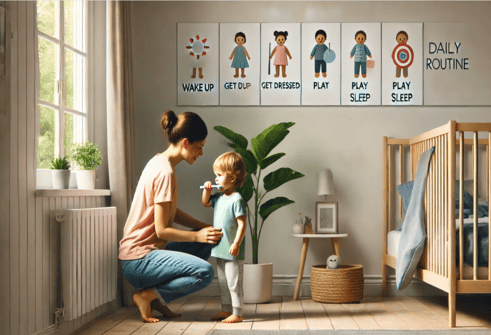Routines help children feel safe, secure, and confident in their world. When daily life is predictable, young children know what to expect—and that reduces anxiety and behavioral challenges. A healthy routine doesn’t have to be rigid. Instead, it should create structure while leaving room for flexibility and joy.
In this article, you’ll learn how to create a simple, age-appropriate daily routine that supports your child’s development and strengthens your bond.
Why Routines Matter for Young Children
Routines are powerful for several reasons:
- Provide a sense of security – Children thrive in predictable environments.
- Promote independence – Kids learn what to do and begin to take responsibility.
- Improve behavior – Clear routines reduce power struggles and tantrums.
- Support emotional regulation – Children handle transitions better when they know what’s coming next.
- Encourage healthy habits – Routines support sleep, hygiene, nutrition, and more.
A well-designed routine becomes the rhythm of the day, allowing children to feel calm and capable.
Keep It Age-Appropriate
For toddlers and preschoolers, routines should be simple and based on consistent timing rather than a strict clock.
Instead of thinking “at exactly 7:00 AM we do this,” think in sequences:
- Wake up → Brush teeth → Get dressed → Eat breakfast
- Play → Snack → Outdoor time → Lunch → Nap
- Quiet time → Dinner → Bath → Bedtime story → Sleep
These sequences help your child understand what comes next and reduce resistance.
Include the Essentials
A healthy routine should include these basic components:
- Consistent wake-up and bedtime
- Nutritious meals and snacks
- Active play (indoors and outdoors)
- Rest time or naps
- Reading and quiet time
- Personal hygiene (brushing teeth, hand washing, etc.)
- Positive interaction with caregivers
Build your schedule around these moments while leaving space for free play and flexibility.
Create a Morning Routine
Mornings set the tone for the day. A calm and predictable start can reduce stress for both you and your child.
Try something like:
- Wake up at the same time each day
- Use a cheerful “good morning” ritual (a song, a cuddle, or a silly dance)
- Brush teeth and wash face
- Get dressed together
- Eat a healthy breakfast
- Talk about the day ahead
Keep transitions smooth by using visual cues or a picture schedule for younger children.
Balance Activity and Rest
Young children have bursts of energy followed by the need to rest. Balance active play with downtime to avoid overstimulation and meltdowns.
Examples:
- After outdoor play, read a book together.
- After lunch, have a quiet nap or rest time.
- After busy mornings, do a creative activity like drawing or puzzles.
This rhythm helps regulate your child’s energy and mood.
Establish a Consistent Bedtime Routine
Sleep is essential for development, and a good bedtime routine can make it easier for your child to fall asleep and stay asleep.
A simple evening routine might include:
- Bath time
- Pajamas and brushing teeth
- Reading a story together
- Cuddles and a lullaby
- Lights out at the same time every night
Avoid screens before bed and keep the bedroom calm and quiet.
Involve Your Child in the Routine
Letting your child participate in planning and following the routine helps them feel empowered.
Try:
- Using a visual schedule with pictures
- Giving them small responsibilities like choosing clothes or setting the table
- Offering simple choices: “Do you want to brush teeth before or after pajamas?”
When kids feel involved, they’re more likely to cooperate.
Be Flexible When Needed
Life with young children is unpredictable. Illness, outings, or mood changes can affect your routine. That’s okay.
Use your routine as a guide, not a rigid schedule. The key is to return to consistency as soon as possible. Flexibility teaches children how to adapt while still feeling secure.
Praise and Celebrate Cooperation
When your child follows the routine well, let them know you noticed!
Say things like:
- “You got dressed all by yourself—great job!”
- “You were so calm during bedtime. That helped us both feel relaxed.”
- “Thank you for brushing your teeth without reminders!”
Positive feedback encourages continued cooperation and builds confidence.
Final Thoughts: Routines Create Calm
A healthy routine is one of the greatest gifts you can give your child. It provides structure without stress, supports development, and strengthens the bond between you.
With patience, consistency, and a little creativity, your routine can transform daily life into a rhythm that nurtures peace, learning, and joy—for both of you.
